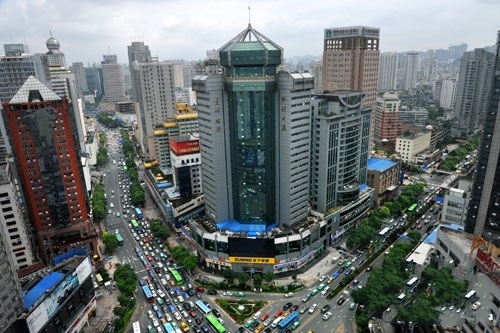
old Guiyang photos – Dashizi (Zhonghua Rd & Zhongshan Rd) in the 1940s, from 贵阳老照片, 2003, ISBN 7-221-06271-4/K-725, posted at: http://www.flickr.com/photos/98531730@N02/9998463924/in/photostream/

old Guiyang photos – celebration of founding of PRC, 1949, seems to be on Zhonghua Rd near Dashizi, uploaded at: http://www.flickr.com/photos/98531730@N02/9998463964/in/photostream/

old Guiyang photos – Dashizi (Zhonghua Rd & Zhongshan Rd) in the mid-late 1950s, celebration of collectivization, uploaded at: http://www.flickr.com/photos/98531730@N02/9998463954/in/photostream/

old Guiyang photos – Dashizi (Zhonghua Rd & Zhongshan Rd) with Zhonghua Middle Rd in upper right,undated, from 贵阳老照片. 2003, ISBN 7-221-06276-5/K-727, uploaded at: http://www.flickr.com/photos/98531730@N02/9998463934/in/photostream/

Dashizi 大十字 today

1930s Guiyang street scene 30年代贵阳, 30年代贵阳繁华地段。from http://shanshuiqiancheng.soufun.com/bbs/3314011348~-1/53710480_53710480.htm, uploaded at: http://www.flickr.com/photos/98531730@N02/9480807336/in/set-72157634952466595/

old Guiyang photos – from Dashizi looking S on Zhonghua Middle Rd 1996 & 2008, photos from 图说贵阳, ISBN 978-7-5614-4916-5, posted at: http://www.flickr.com/photos/98531730@N02/9998178615/in/photostream/

old Guiyang photos – from Dashizi looking N on Zhonghua Middle Rd toward Penshuchi 2002 & 200_, photos from 图说贵阳, ISBN 978-7-5614-4916-5, uploaded at: http://www.flickr.com/photos/98531730@N02/9998178225/in/photostream/

old Guiyang photos – looking N on Zhonghua South Rd toward Dashizi 1996, photos from 图说贵阳, ISBN 978-7-5614-4916-5, uploaded at: http://www.flickr.com/photos/98531730@N02/9998178795/in/photostream/

old Guiyang photos – looking N on Zhonghua South Rd toward Dashizi 2008, photos from 图说贵阳, ISBN 978-7-5614-4916-5, posted at: http://www.flickr.com/photos/98531730@N02/9998178805/in/photostream/

Penshuichi in the 1960s – 60年代的喷水池

former Water Fountain (now paved over) 喷水池, Guiyang, uploaded at: http://www.flickr.com/photos/98531730@N02/9482921909/in/set-72157634952466595/ 【黔城往事】“喷水池”最后一瞥 作者:黔山毛豆 日期:2010-02-25, 现在就是历史。贵阳市最繁华的“喷水池”原名“铜像台”,因铸造有周西成一尊铜像而得名。1933年开始筹建,历时两年半,于1935年夏建成。1952年拆除铜像,改建为街心花园,中有喷泉,称为喷水池。此后,喷水池经过数度改造,终成为照片中的模样。2010年2月18日凌晨,喷水池拆除工程动工,将拆除现有环岛和雕塑,改为十字交叉口;在交叉口设置四个交通导流岛,导流岛内设喷泉小品和绿化,兼顾城市景观和延续“喷水池”历史传统。拆除以后,那个被贵阳人称为“巨大背篼”的城市雕塑将如何处置?择地放置?当废金属卖掉?或是融掉?(from http://www.qtwm.com/default.asp?tag=%e9%bb%94%e5%9f%8e%e5%be%80%e4%ba%8b&page=3 )

old Guiyang photos – Penshuichi looking NE 1996 & 2008, photos from 图说贵阳, 2010, ISBN 978-7-5614-4916-5, posted at: http://www.flickr.com/photos/98531730@N02/9998463524/in/photostream/

old Guiyang photos – from Penshuichi looking N on Zhonghua North Rd 1997 & 2008, photos from 图说贵阳, ISBN 978-7-5614-4916-5, uploaded at: http://www.flickr.com/photos/98531730@N02/9998178035/in/photostream/


Penshuichi 喷水池 today

old map of Guiyang (Guizhou).18th century,French 贵阳历史地图, posted at: http://www.flickr.com/photos/98531730@N02/9473752520/in/set-72157634952466595/

old Guiyang map 贵阳老地图, from 图说贵阳, ISBN 978-7-5614-4916-5, uploaded at: http://www.flickr.com/photos/98531730@N02/10000341595/

downtown Guiyang map today
Guiyang has grown exponentially since the 1990s. The city’s heart is around the 大十字 (literally “Big Cross”) which is a cross, resembling the Chinese character for ten, and 喷水池 (literally “Fountain Pool”) which is a traffic intersection which had a large fountain at its center, until the fountain was paved over in early 2010 to help improve the flow of traffic.
The city is situated on the Nanming River, a headstream of the Wu River, which eventually joins the Yangtze River at Fuling, Chongqing. Guiyang is a natural transportation center, with comparatively easy access northward to Sichuan, eastward to Guangxi and Guangdong, westward to Yunnan, and northeast to Hunan province.
History of Guiyang
The city was first constructed as early as 1283 AD during the Yuan Dynasty. It was originally called Shunyuan (順元), meaning obeying the Yuan (the Mongol rulers).
Originally the area was populated by non-Chinese. The Sui Dynasty (AD 581–618) had a commandery there, and the Tang dynasty (618–907) a prefecture. They were, however, no more than military outposts, and it was not until the Yuan (Mongol) invasion of southwest China in 1279 that the area was made the seat of an army and a “pacification office.” Chinese settlement in the area also began at that time, and, under the Ming (1368–1644) and Qing (1644–1911) dynasties, the town became the seat of a superior prefecture named Guiyang.
Locally Guiyang was an important administrative and commercial center with two distinct merchant communities, consisting of the Sichuanese, who lived in the “new” northern part of the city, and those from Hunan, Guangdong, and Guangxi province, who lived in the “old” southern part. Nevertheless, until the Sino-Japanese War (1937–45), Guiyang was no more than the capital of one of China’s least-developed provinces. As elsewhere in the southwest, considerable economic progress was made under the special circumstances of wartime. Road transport infrastructure with Kunming in Yunnan province and with Chongqing in Sichuan (China’s wartime provisional capital) and into Hunan were established. Work was begun on a railway from Liuzhou in Guangxi, and after 1949 this development was accelerated. Guiyang has subsequently become a major provincial city and industrial base. In 1959 the rail network in Guangxi was completed, allowing seamless connection from Guizhou to Chongqing to the north, to Kunming to the west, and Changsha to the east.
(from Wikipedia, en.wikipedia.org/wiki/Guiyang )

books with photos of old Guiyang – Guizhou Provincial Library, Beijing Rd near Guizhou Museum, 5th fl. Local Collections Reading Room. Open every day.
